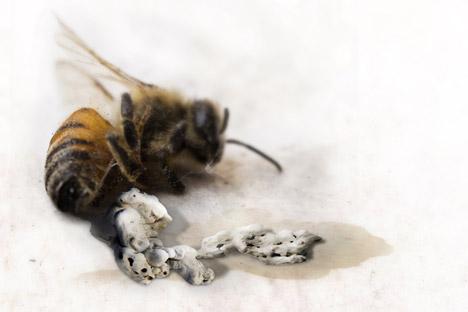In the past we have seen where bees have been put to use in an art project where they 3D print shapes via honeycombs. Now a man named Geoff Manaugh, former editor-in-chief of tech website Gizmodo and designer John Becker have come up with a bioengineering scenario in which bees would replace 3D printers. In an interview with Dezeen Magazine, the duo lay out a scenario in which the bees of the future would be genetically modified and trained to print and repair buildings and other structures by producing a concrete-like material from their glands, instead of producing honey.
According to Manaugh, the bees would be able to repair structures after being housed inside a mold that is in the shape of the area needing repair. Though Manaugh said in his scenario that bees would eventually be able to create free-standing structures from scratch, but he hasn’t laid out exactly how that would be accomplished.
Manaugh and Becker came up with the idea of “construction worker” bees after reading about entities such as the U.S. military and the Massachusetts Institute of Technology using genetically modified animals to create things such as weapons-grade silk and enclosures. The duo think that bees and other genetically modified animals make better “factories” than the ones people currently use.
“The notion that we could abandon industrial dyes, fossil fuels, artificial adhesives, and other toxic, carcinogenic, or environmentally damaging materials and, instead, work humanely with the bodies of animals to produce viable alternatives is actually an enormously exciting possibility,” said Manaugh. “It combines synthetic biology with biomimetics, and suggests that the future of industrial production might someday be visually indistinguishable from a rain forest, coral reef, or garden.”
Also, the process to convert worker bees into actual construction workers wouldn’t be that much of a leap from what nature intended as some bees already produce natural products that are similar to those created in labs.
“There is already a species of bee native to New England that naturally produces a cellophane-like polymer that could, in theory, be used as an industrial alternative to plastic, one that does not require the use of fossil fuels; and something as simple as a special dietary regime for silkworms resulted in naturally dyed silk, free from industrial inks or coloring,” said Manaugh. “It was examples like these — and there are dozens — that inspired us and kept the idea moving forward.”
Though Manaugh and Becker think their idea is a viable alternative to the way things are currently done, they made it clear that their idea is speculative and not a blueprint for a brave, new, bee-built world.
“Living creatures are not just an industrial resource for humans to use and exploit, turning them into 3D printheads on a whim,” said Manaugh. “This is another reason why our idea of printing architecture using genetically modified bees is presented as the plot of a fictional story, not as an actual biological design proposal for 3M or BASF to consider investing in.”
Regardless, such a possibility certainly is intriguing. Imagine bees that are able to be placed on certain damaged areas of buildings, which can then 3D print a concrete-like substance from their glands, similar to they way in which they produce honey. Certainly animal rights groups may not a green with such a manipulation of the natural abilities of these creatures, however, the benefits could outweigh the harm done, if any to the bees. What do you think? Is such a concept a future possibility? Let us know your thoughts in the Bee 3D printer forum thread on 3DPB.com.
[Source: Dezeen]Subscribe to Our Email Newsletter
Stay up-to-date on all the latest news from the 3D printing industry and receive information and offers from third party vendors.
You May Also Like
3D Printing Financials: Fathom Struggles in Financial Quicksand During Critical Transition
Facing a year of key transitions and financial pressures, Fathom (Nasdaq: FTHM) has filed its annual report for 2023 with the U.S. Securities and Exchange Commission (SEC). The document outlines...
Latest Earnings Overview for Australian 3D Printing Firms Titomic and AML3D
Australian 3D printing manufacturing firms Titomic (ASX: TTT) and AML3D (ASX: AL3) reported their financial results for the period from July to December 2023, marking the first half of their...
3D Printing Webinar and Event Roundup: April 7, 2024
Webinars and events in the 3D printing industry are picking back up this week! Sea-Air-Space is coming to Maryland, and SAE International is sponsoring a 3D Systems webinar about 3D...
3D Printing Financials: Unpacking Farsoon and BLT’s 2023 Performance
In the Chinese 3D printing industry, two companies, Farsoon (SHA: 688433) and Bright Laser Technologies, or BLT (SHA: 688333), have recently unveiled their full-year earnings for 2023. Farsoon reported increases...


































